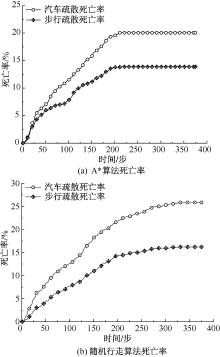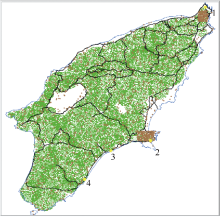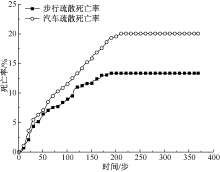| [1] |
鲁义, 周钦云, 邵淑珍, 等. 气候因子对我国森林火灾的影响及预测[J]. 中国安全科学学报, 2023, 33(12): 53-59.
doi: 10.16265/j.cnki.issn1003-3033.2023.12.1736
|
|
LU Yi, ZHOU Qinyun, SHAO Shuzhen, et al. Influence and prediction of climatic factors on forest fires in China[J]. China Safety Science Journal, 2023, 33(12): 53-59.
doi: 10.16265/j.cnki.issn1003-3033.2023.12.1736
|
| [2] |
PAUSAS J G, KEELEY J E. Wildfires and global change[J]. Frontiers in Ecology and the Environment, 2021, 19(7): 387-395.
|
| [3] |
MAKINECI B H. Investigation of burned areas with multiplatform remote sensing data on the Rhodes 2023 forest fires[J]. Ain Shams Engineering Journal, 2024, 15: DOI: 10.1016/j.asej.2024.102949.
|
| [4] |
MASS C, OVENS D. The meteorology of the August 2023 Maui wildfire[J]. Weather and Forecasting, 2024, 39(8): 1097-1115.
|
| [5] |
YIN Jianpeng, HE Binbin, FAN Chunquan, et al. Drought-related wildfire accounts for one-third of the forest wildfires in subtropical China[J]. Agricultural and Forest Meteorology, 2024, 346: DOI: 10.1016/j.agrformet.2024.109893.
|
| [6] |
JIANG Wenyu, WANG Fei, FANG Linghang, et al. Modelling of wildland-urban interface fire spread with the heterogeneous cellular automata model[J]. Environmental Modelling & Software, 2021, 135: DOI: 10.1016/j.envsoft.2020.104895.
|
| [7] |
SINGH H, ANG L M, LEWIS T, et al. Trending and emerging prospects of physics-based and ML-based wildfire spread models: a comprehensive review[J]. Journal of Forestry Research, 2024, 35(1): DOI: 10.1007/s11676-024-01783-x.
|
| [8] |
KHACHUMOV M, KHACHUMOV V. Optimization models of UAV route planning for forest fire monitoring[C]. 2022 International Russian Automation Conference. IEEE, 2022: 272-277.
|
| [9] |
XING Zhewen, ZHANG Youmin, SU Chunyi, et al. Measuring the horizontal wind for forest fire monitoring using multiple UAVs[C]. 2019 Chinese Control Conference (CCC). IEEE, 2019: 4945-4950.
|
| [10] |
JOHN J, HARIKUMAR K, SENTHILNATH J, et al. An efficient approach with dynamic multiswarm of UAVs for forest firefighting[J]. IEEE Transactions on Systems, Man, and Cybernetics: Systems, 2024, 54(5): 2860-2871.
|
| [11] |
INNOCENTE M S, GRASSO P. Self-organising swarms of firefighting drones: harnessing the power of collective intelligence in decentralised multi-robot systems[J]. Journal of Computational Science, 2019, 34: 80-101.
|
| [12] |
UMEKI K, TANAKA T, NAKAMURA Y, et al. Large-scale evacuation shelter selection method through iterations of pedestrian simulations with dynamic congestion reproduction[J]. IEEE Access, 2022, 10: 89 387-89 401.
|
| [13] |
SHARMA J, ANDERSEN P A, GRANMO O C, et al. Deep Q-learning with Q-matrix transfer learning for novel fire evacuation environment[J]. IEEE Transactions on Systems, Man, and Cybernetics: Systems, 2020, 51(12): 7363-7381.
|
| [14] |
IANCU L D, DRAGOI P A, DELCEA C. Computer modeling of evacuation patterns comparison and crowd dynamics: a use of NetLogo[C]. IBIMA Conference on Artificial intelligence and Machine Learning. Cham: Springer Nature Switzerland, 2023: 356-367.
|
| [15] |
GRAJDURA S, BORJIGIN S, NIEMEIER D. Fast-moving dire wildfire evacuation simulation[J]. Transportation Research Part D: Transport and Environment, 2022, 104: DOI: 10.1016/j.trd.2022.103190.
|
| [16] |
LUO Qiang, WANG Haibao, ZHENG Yan, et al. Research on path planning of mobile robot based on improved ant colony algorithm[J]. Neural Computing and Applications, 2020, 32: 1555-1566.
|
| [17] |
SIVRIKAYA F, KÜÇÜK Ö. Modeling forest fire risk based on GIS-based analytical hierarchy process and statistical analysis in Mediterranean region[J]. Ecological Informatics, 2022, 68: DOI: 10.1016/j.ecoinf.2021.101537.
|
| [18] |
RUDKE A P, DE SOUZA V A S, DOS SANTOS A M, et al. Impact of mining activities on areas of environmental protection in the southwest of the Amazon: a GIS-and remote sensing-based assessment[J]. Journal of environmental management, 2020, 263: DOI: 10.1016/j.jenvman.2020.110392.
|
| [19] |
王丽, 李育萌, 刘云, 等. Zigbee耦合A*算法的疏散路径动态规划与指示系统[J]. 中国安全科学学报, 2023, 33(11): 142-149.
doi: 10.16265/j.cnki.issn1003-3033.2023.11.0939
|
|
WANG Li, LI Yumeng, LIU Yun, et al. A dynamic planning and indication system for evacuation paths based on Zigbee coupled A* algorithm[J]. China Safety Science Journal, 2023, 33(11): 142-149.
doi: 10.16265/j.cnki.issn1003-3033.2023.11.0939
|
| [20] |
KAUR N, KAUR H. A multi-agent based evacuation planning for disaster management: a narrative review[J]. Archives of Computational Methods in Engineering, 2022, 29(6): 4085-4113.
|





























